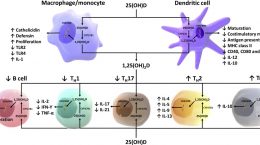Published on September 4, 2023
Get 10% Off through Tomorrow! PLUS Learn how to reduce COVID severity and Long COVID risk by addressing inflammation and immune dysregulation
Key Points
- Inflammation and immune dysregulation have been associated with increased risk of severe COVID and Long COVID
- An estimated 10-30% of people who have been infected with SARS-CoV-2 experience symptoms of Long COVID. The highest percentage of cases occur in individuals between 36 and 50 years of age who experienced mild COVID-19 symptoms during their acute phase.
- Listed below are several markers that could be measured and optimized in order to address potential underlying factors contributing to ongoing inflammation and immune dysregulation

With COVID making news again, and flu season right around the corner, now is the time to check in to your body’s current status of inflammation and immune supporting nutrient levels – especially vitamin D!
Taking steps to get inflammation under control and ensuring target levels of these nutrients can make a difference not only in the risk of COVID and other viral infections, but also in our overall health.
Measure Today with 10% Off! Use Code STAYHEALTHY10
PLUS get the Vitamin D & COVID-19: A Summary of Published Research eBook Free with your purchase (a $15 value)… Hurry, promo ends tomorrow, Tuesday September 5th!
Nutrient Deficiencies May Lead to Improper Immune and Inflammatory Response to Viral Infections
 Ensuring adequate micronutrient status well before exposure to viral infections including COVID can help lessen the chance of infection as well as the chance of severe symptoms and death, and also the chance of Long COVID. This has been demonstrated by multiple studies where vitamin D supplementation and/or status is evaluated along with disease progression. These studies and several studies on other nutrients as they relate to COVID-19 (such as omega-3s, zinc and magnesium) are reviewed in the Vitamin D & COVID-19: A Summary of Published Research eBook, FREE with your test kit purchase through tomorrow with code STAYHEALTHY10.
Ensuring adequate micronutrient status well before exposure to viral infections including COVID can help lessen the chance of infection as well as the chance of severe symptoms and death, and also the chance of Long COVID. This has been demonstrated by multiple studies where vitamin D supplementation and/or status is evaluated along with disease progression. These studies and several studies on other nutrients as they relate to COVID-19 (such as omega-3s, zinc and magnesium) are reviewed in the Vitamin D & COVID-19: A Summary of Published Research eBook, FREE with your test kit purchase through tomorrow with code STAYHEALTHY10.
Inflammation and Immune Dysregulation Increase the Risk of Long COVID
An estimated 10-30% of people who have been infected with SARS-CoV-2 experience symptoms of Long COVID. The highest percentage of cases occur in individuals between 36 and 50 years of age who experienced mild COVID-19 symptoms during their acute phase.
The symptoms of Long COVID affect multiple organ systems and often include brain fog, shortness of breath, and chronic fatigue. Long COVID has also been shown to increase the risk of worsening existing health problems, and inducing new onset conditions, including type 2 diabetes, cardiovascular and cerebrovascular disease, and dysautonomia [especially postural orthostatic tachycardia syndrome (POTS)].
A review by Davis et al. lists the main contributors to Long COVID as inflammation, autoimmunity, and immune dysregulation. Other possibilities include an inability of the body to clear the virus from the tissues, blood clotting with endothelial dysfunction, imbalance of the gut microbiome, and re-activated viruses (including Epstein-Barr and human herpesvirus 6). High levels of multiple autoantibodies that target different tissues and organ systems have been found in patients with COVID-19 and Long COVID, indicating an autoimmune component as well.
What Can be Done to Address Inflammation and Immune Dysregulation?
While diet and lifestyle changes, such as increasing exercise, losing weight, and quitting smoking, can help lower inflammation levels and improve immune function, there are several markers that could be measured and optimized in order to address potential underlying factors contributing to ongoing inflammation and immune dysregulation.
Get Vitamin D Levels to 50 ng/ml (125 nmol/L) or Higher
Vitamin D has demonstrated anti-infective, anti-inflammatory, and immunomodulatory properties, and it has been shown to reduce the risk of autoimmune disease. Multiple studies have linked vitamin D deficiency to increased severity and death due to COVID-19; it is known to affect the immune response in several important ways, specifically against viral infections. One of the most important ways vitamin D helps protect against COVID-19 is through its role in modulating inflammation and preventing the cytokine storm, which could also be a reason vitamin D has been shown to help prevent chronic diseases such as diabetes. Vitamin D works directly on the cells of the immune system, and many of these cells also produce their own vitamin D by expressing vitamin D converting enzymes to manufacture site-specific 25(OH)D and 1,25D.
Evidence points to a minimum 25(OH)D level of 50 ng/ml (125 nmol/L) to fully optimize these demonstrated anti-inflammatory and immune regulating properties of vitamin D.
Balance Omega-3s and Omega-6s with an Omega-3 Index of 8% or Higher
Omega-3 and omega-6 fatty acids are poly-unsaturated fatty acids (PUFAs) that work together to directly regulate inflammation, immune function, and pain. Omega-6s (such as AA) are pro-inflammatory, essential for initiating and sustaining the inflammatory response – a physiologic function necessary for healing from injuries and infection. Omega-3s (such as DHA and EPA) are anti-inflammatory and promote the resolution of the inflammatory process. More specifically, AA plays an important role in the initiation of acute inflammation, which then becomes moderated by the involvement of omega-3s (EPA and DHA) as they replace AA, and with the help of vitamin D, begin to resolve inflammation.
The Omega-3 Index is a blood test used to measure the amount of EPA and DHA in red blood cell (RBC) membranes and is expressed as a percent of total RBC fatty acids. A higher Omega-3 Index is associated with a higher omega-3 status, lower levels of chronic inflammation, and better health outcomes. Omega-3s help mediate the immune response and are anti-inflammatory to help promote the resolution of the inflammatory process and prevent tissue damage due to inflammation. In fact, one study found that an Omega-3 Index of at least 6.6%, and possibly as high as 8.5%, is indicative of a quiescent, balanced innate-adaptive immune system.
The AA:EPA ratio is a measure of the primary pro/anti-inflammatory fatty acids. Higher levels of AA lead to a higher AA:EPA ratio, promoting inflammation and the development of chronic disease.
Some experts consider the desirable range for the AA:EPA ratio to be 2.5 to 11; others consider a range or 1.5 to 3 to be low risk, 3 to 6 to be moderate risk, 7-15 to be elevated risk, and above 15 to be high risk.
Reduce High Sensitivity C-Reactive Protein (hs-CRP)
C-reactive protein (CRP) is a protein produced by the liver in response to a very broad range of causes, such as infection from hepatitis to cancer, and is used as a general marker of inflammation. Elevated CRP levels have been linked to future heart attacks, stroke, peripheral arterial disease, metabolic syndrome, the development of diabetes, and many other chronic diseases.
The CRP test blood spot test offered by GrassrootsHealth uses a high sensitivity assay, hs-CRP where “hs” means high sensitivity, to detect small elevations in CRP.
Evidence suggests that levels below 1.0 mg/L indicate low inflammation and low risk of cardiovascular disease, levels between 1.0 and 3.0 mg/L indicate average risk, and levels between 3.1 and 10 mg/L indicate increased risk (levels above 10 mg/L most likely indicate an acute infection or injury).
Measure Hemoglobin A1c Test (HbA1c)
HbA1c is a measure of how healthy average blood sugar levels have been in the recent few months, and is a better representation of blood sugar health than a single glucose measurement, since glucose levels vary throughout the day. HbA1c is the compound formed in the blood when a hemoglobin molecule in a red blood cell binds with a glucose molecule in the blood; the resulting molecule is also known as glycated hemoglobin. It can be a good indicator of glucose intolerance even in the absence of abnormal fasting glucose levels, and higher levels of HbA1c are associated with increased levels of inflammation in the body.
A healthy A1c level is less than 5.7%, while greater than 6.5% indicates diabetes, and between 5.7-6.5% represents prediabetes (see this post for special circumstances).
Ensure Adequate Magnesium, Zinc and Selenium
Multiple studies have observed associations between low magnesium intake and levels, and increased levels of inflammation and oxidative stress. A new study has shown the relationship between serum magnesium levels and the onset of Long COVID. This study found a 114% increased risk of Long COVID among participants whose serum magnesium levels were at or below 1.96 mg/dL at the beginning of their COVID-19 disease, compared to those magnesium levels were higher.
Selenium and zinc are also important to immune system function. Selenium has antioxidant, anti-inflammatory, immunomodulatory, anti-carcinogenic and antiviral properties. Selenium deficiency has been linked to increased risk of cancer, cardiovascular, thyroid, neurodegenerative and infectious diseases, as well as inflammation and immunodeficiency.
Zinc is a nutrient known to benefit the immune system, and deficiency of zinc impairs the capacity of many different immune cells to carry out their functions. Zinc has been shown to significantly reduce the duration and severity of the common cold, and to help prevent viral respiratory tract infections. Deficiency of zinc is common in the elderly, and subclinical zinc deficiency may be responsible for higher rates of infections and degenerative pathologies that are related to age.
Choose which markers to measure now and get 10% Off plus get our Vitamin D & COVID-19 research summary eBook free when you use the code STAYHEALTHY10 (hurry, promo ends tomorrow, Tuesday September 5th)!
Measure Your Levels through D*action Today!
Create Your Custom Home Test Kit
 Measure your vitamin D and Omega-3 levels at home as part of the D*action project! To know if you are getting enough, make sure you test today!
Measure your vitamin D and Omega-3 levels at home as part of the D*action project! To know if you are getting enough, make sure you test today!
You can also measure your:
- Vitamin D
- Magnesium PLUS Essential and Toxic Elements
- Omega-3 Fatty Acids
- hsCRP
- HbA1c
- TSH
- Type 1 Diabetes Autoantibodies
Did you know that each of the above can be measured at home using a simple blood spot test? As part of our ongoing research project, you can order your home blood spot test kit to get your levels, followed by education and steps to take to help you reach your optimal target levels. Start by enrolling and ordering your kit to measure each of the above important markers, and make sure you are getting enough of each to support better mood and wellbeing!
Create your custom home test kit today. Take steps to improve the status of each of these measurements to benefit your overall health. With measurement you can then determine how much is needed and steps to achieve your goals. You can also track your own intakes, symptoms and results to see what works best for YOU.







